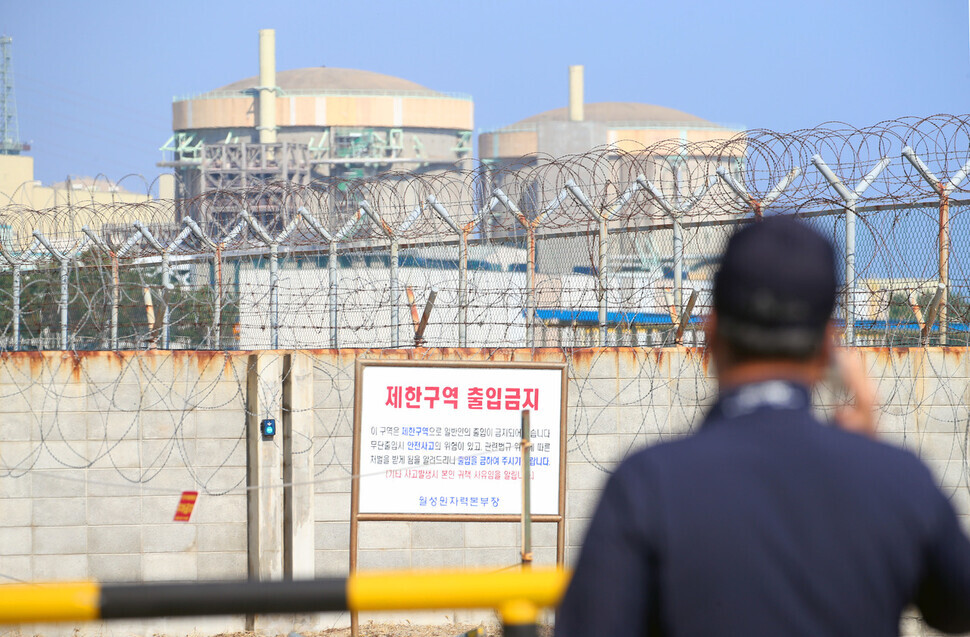hankyoreh
Links to other country sites 다른 나라 사이트 링크
Investigation points to spent resin tank as source of leaked tritium at Wolseong nuclear plant

A South Korean Nuclear Safety and Security Commission (NSSC) tritium investigation team identified a spent resin tank (SRT) as the source of high concentrations of tritium detected at a groundwater observation well at the Wolseong nuclear plant in Gyeongju, North Gyeongsang Province.
Its conclusions conflict with the explanation of the plant’s operator, Korea Hydro & Nuclear Power (KHNP), which said in the initial stages of the leakage controversy in early 2021 that the high tritium concentrations at the well were likely to have come from tritium released into the atmosphere rather than underground facilities.
On Wednesday, the investigation team released a report on the progress of its second tritium investigation at the Wolseong plant and future plans. In it, it said, “The cause of the high tritium concentration in groundwater at Wolseong Nuclear Power Plant observation well (WS-2) is judged to be water leaked from the No. 1 reactor’s spent resin storage tank.”
Spent resin storage tanks are concrete structures analogous to swimming pools, in which resin is placed after radioactive substances from nuclear power plant operation have been adsorbed from them. Each reactor has three of them in place.
“As a result of leaked water from a spent resin storage tank entering the No. 1 reactor’s retaining wall drainage along with surrounding groundwater, tritium was detected at a rate of 3.83 million becquerels [Bq] per liter on Dec. 27 of last year in the No. 5 draining hole near the storage tank,” the investigation team said.
“Due to its leakage as accumulated groundwater in the retaining wall storage tank was released through rainwater piping, tritium concentrations at the nearby WS-2 observation well are estimated to have risen to 28,200 Bq/L,” it added.
The team also made plans to launch a detailed investigation within the site this month in order to check whether tritium may have leaked outside the plant site through the groundwater, as environmental groups have suggested. For that investigation, exploratory holes are to be drilled to determine the pathway of groundwater movement, after which state-of-the-art groundwater modeling techniques will be used to assess the spread of radioactive materials.
“Based on the reports [of investigations by KHNP and others], we can’t yet conclude definitively that there has been external leakage, so we will be drilling around five exploratory holes to check,” explained Hong Sung-gul, a professor of architecture at Seoul National University who heads the investigation team.
By Kim Jeong-su, senior staff writer
Please direct questions or comments to [english@hani.co.kr]

Editorial・opinion
![[Column] Season 2 of special prosecutor probe may be coming to Korea soon [Column] Season 2 of special prosecutor probe may be coming to Korea soon](https://flexible.img.hani.co.kr/flexible/normal/500/300/imgdb/original/2024/0426/3317141030699447.jpg) [Column] Season 2 of special prosecutor probe may be coming to Korea soon
[Column] Season 2 of special prosecutor probe may be coming to Korea soon![[Column] Park Geun-hye déjà vu in Yoon Suk-yeol [Column] Park Geun-hye déjà vu in Yoon Suk-yeol](https://flexible.img.hani.co.kr/flexible/normal/500/300/imgdb/original/2024/0424/651713945113788.jpg) [Column] Park Geun-hye déjà vu in Yoon Suk-yeol
[Column] Park Geun-hye déjà vu in Yoon Suk-yeol- [Editorial] New weight of N. Korea’s nuclear threats makes dialogue all the more urgent
- [Guest essay] The real reason Korea’s new right wants to dub Rhee a founding father
- [Column] ‘Choson’: Is it time we start referring to N. Korea in its own terms?
- [Editorial] Japan’s rewriting of history with Korea has gone too far
- [Column] The president’s questionable capacity for dialogue
- [Column] Are chaebol firms just pizza pies for families to divvy up as they please?
- [Column] Has Korea, too, crossed the Rubicon on China?
- [Correspondent’s column] In Japan’s alliance with US, echoes of its past alliances with UK
Most viewed articles
- 1‘We must say no’: Seoul defense chief on Korean, USFK involvement in hypothetical Taiwan crisis
- 2[Editorial] Korea’s surprise Q1 growth requires objective assessment, not blind fanfare
- 3[Column] Season 2 of special prosecutor probe may be coming to Korea soon
- 4Division commander ordered troops to enter raging flood waters before Marine died, survivor says
- 5Is Japan about to snatch control of Line messenger from Korea’s Naver?
- 6[Column] ‘Choson’: Is it time we start referring to N. Korea in its own terms?
- 7[Special report- Part III] Curses, verbal abuse, and impossible quotas
- 8Why Korea shouldn’t welcome Japan’s newly beefed up defense cooperation with US
- 9S. Korea “monitoring developments” after report of secret Chinese police station in Seoul
- 10The dream K-drama boyfriend stealing hearts and screens in Japan